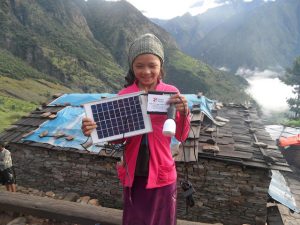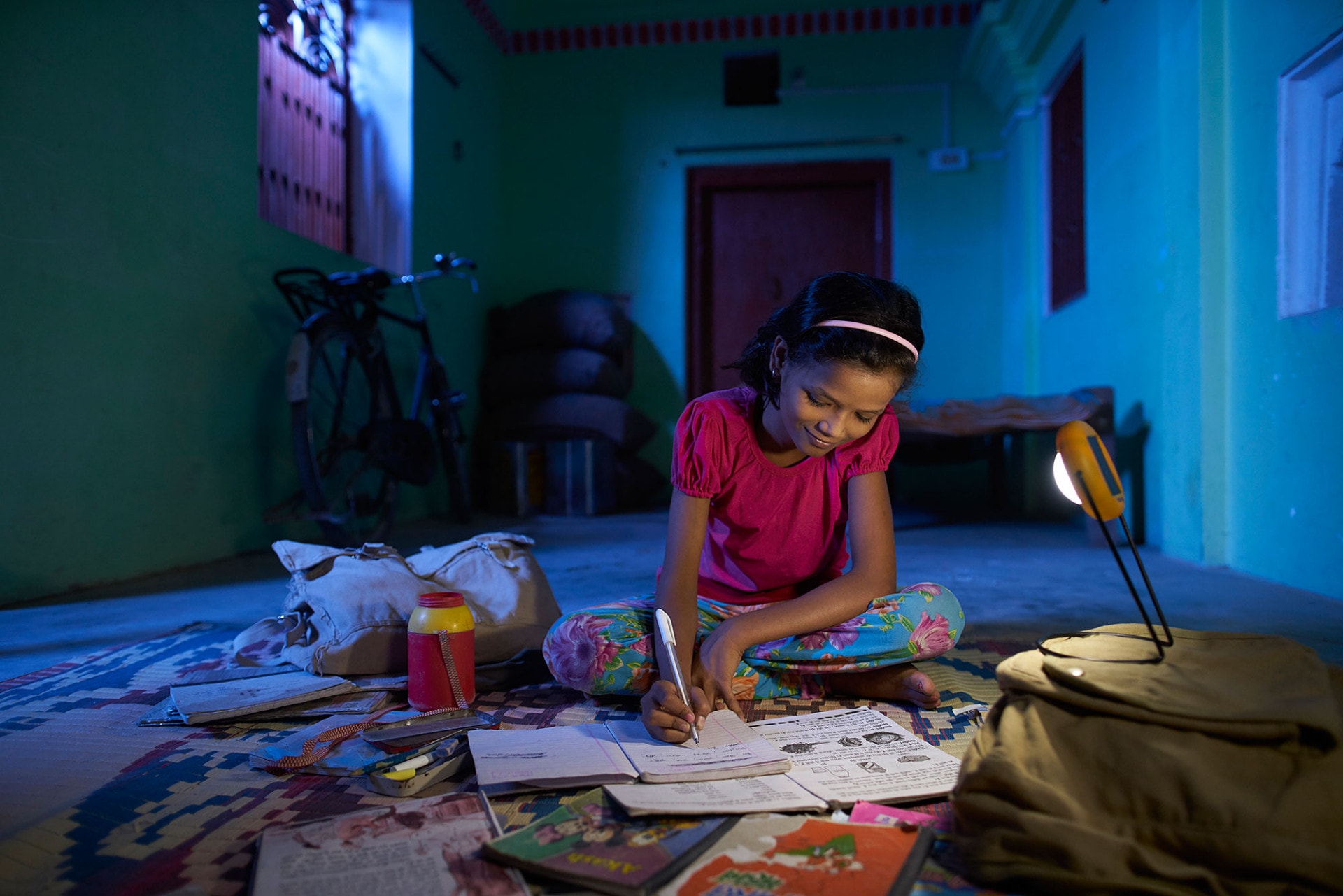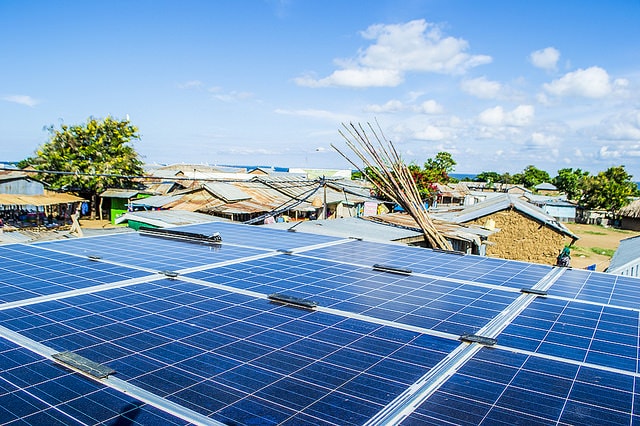EDITOR’S NOTE: THIS PIECE IS PART OF A SERIES EXPLORING THE SUSTAINABLE DEVELOPMENT GOALS. SEE THE INTRODUCTION TO THE SERIES HERE.
Lessons Learned from Ashden’s Experience
Towards the end of last year, two momentous events took place that, if commitments and promises are kept, should help to speed up access to sustainable energy for the 1.1 billion people who currently lack access to electricity and the 2.9 billion without access to modern fuels for cooking and heating.
History in the making
In a historic move in December, 196 countries signed a global climate agreement which aims to hold the rise of global temperatures to a maximum of 1.5 degrees Celsius. The Paris Agreement sent a clear signal that there is an end in sight to the fossil fuel age and that clean green renewable energies are the best chance we have of reaching a new goal of zero net emissions by later this century.
A few weeks prior to the climate talks, United Nations member states formally adopted a new sustainable development agenda with 17 global goals including SDG 7, pledging “to ensure access to affordable, reliable, sustainable and modern energy for all.” A cross-cutting goal, affordable and clean energy is essential for improving health (SDG 3); for lighting homes so that children can study after dark and have a chance of a quality education (SDG 4); for freeing women up from labour-intensive domestic tasks like collecting firewood for cooking (SDG5); and for supporting businesses and employment opportunities (SDG 8).
The energy goal is key to global economic growth and environmental sustainability and builds on the SE4All initiative that brought together the public sector, private sector, and civil society around the goals of ensuring universal access to modern energy services; doubling the rate of improvement in energy efficiency; and doubling the share of renewable energy in the global energy mix.
Even though the global rate of electrification increased from 83 to 85 percent between 2010 and 2012, and 220 million people got energy access for the first time, this growth still needs to be accelerated. According to a recent Bloomberg New Energy Finance off-grid solar report, the International Energy Agency projects that there will still be 530 million people living off-grid by 2040, even though 950 million people will have gained grid access by then, and the absolute number of people living off the grid will continue to rise within the next decade.
Small and medium-size enterprises (SMEs) providing clean energy can help to address the lack of energy access and unreliable grid connections in developing countries. The potential to scale up energy access and provide reliable connectivity is a huge business opportunity and is key to driving economic development.
Innovation in East Africa
East Africa is making the most of these opportunities and is emerging as a hotbed of creative solutions to meeting people’s energy needs. Using a mobile device to transfer funds is increasingly used as a method of payment. Off Grid Electric, an Ashden Award winner in 2014, is a leader in Tanzania, using mobile money to sell solar power as a daily service to off-grid homes at an affordable price. Their pay-as-you-go service is tailored to user needs, with flexible payments, opportunity to change service level, and excellent support from a customer care team and local agents, as well as a sophisticated app-based customer registration and product tracking system.
In photo: Ashden Award winner, SteamaCo’s solar project in rural Kenya. Photo Credit: SteamaCo
In Kenya where 80% of the population lacks access to main electricity, SteamaCo — one of last year’s Ashden International Award winners — is using technology to bring the benefits of clean energy to off-grid customers through solar powered micro-grids. They use a cloud-based remote metering and payments system which monitors energy use, lets the users pay for power using their mobile phones, and quickly troubleshoots any problems. The micro-grids work like mini power stations for each village, supplying enough energy to run small businesses, as well as power TVs, radios, and bright lights in the home.
According to one customer, John Pambio, “There wasn’t enough power to run a soldering iron on my solar-home-system, so people had to take their radios 100km for repair. Now with power from the micro-grid, I can fix them here in Entasopia.”
Another, Ibrahim Chegi, the owner of Club 360 said, “I use the micro-grid power for all the equipment in my Club – lights, sound system, TV, DVD. The power is stable so it doesn’t damage the equipment — that’s a huge benefit to my business.”
Related article: “SDG 7: AFFORDABLE AND CLEAN ENERGY FOR ALL — YOUTH LIGHTING UP THE WORLD“
Finance is key
Start-up enterprises like SteamaCo, which are bringing huge social and economic benefits to off grid communities, need to be able to access the appropriate finance to enable them to scale up and reach many more millions. A report that we published with Christian Aid found that many SMEs delivering clean energy have an unmet need for finance, including grants, debt, and equity.
The need is particularly urgent for working capital. More finance must be made available to meet this need, particularly types that can be accessed quickly and with minimal conditions, ideally with lower interest rates and relaxed exit timeframes, such as lines of credit.
One of the finalists in this year’s Ashden Awards, SunFunder, is addressing this issue by unlocking capital for a reliable source of debt financing that can be easily accessed. It does so by providing investors with the opportunity to lend to a carefully selected portfolio of solar businesses and has so far provided over $8 million of finance to solar businesses in 10 countries, helping them to offer solar electricity to thousands of people.

In photo: Ashden Award winner, SunFunder, solar project in Tanzania Photo Credit: SunFunder
There is general agreement in the sector that we need thriving SMEs in the energy access space, to allow room for innovation and that the private sector needs to play an increased and more active role. What’s needed are more intermediaries like SunFunder who are working to improve the sustainable energy market as a whole rather than the focus falling on a handful of perennial industry favorites. It would be great to see other organisations like this or similar investment vehicles that can help the energy access market build a track record and ultimately entice commercial investors to the sector.
By moving enterprises from seed funding and grants to securing larger, commercially-viable investment needed for expansion and scale-up, we can start to tackle “the Missing Middle” that’s currently impeding progress towards achieving access to affordable and clean energy for all.
Another solution is strategically using development finance and philanthropic funds to mobilize private capital to developing countries and emerging markets, often referred to as blended finance. This can create a win-win situation as government or philanthropic funds are used to leverage private funds and institutional investors have more interesting investing opportunities and make returns on their money, all of which allows more finance to flow into the sector.
For a full mindmap containing additional related articles and photos, visit #SDGStories
Making clean energy affordable for the hard to reach
End-user finance to help customers purchase energy products is also critical. In Asia, the birth place of micro-finance, the one-shop-stop model deployed by 2008 Ashden Award winner Grameen Shakti in Bangladesh was found to be very successful. Technology, after-sales service, and end-user finance tailored to the specific needs of clients are provided under one roof, and as a result, they are bringing solar power and clean cookstoves to over 12 million rural people.
One of our finalists this year, Nepalese organization Gham Power provides tailored financing packages for people wanting to buy a solar microgrid to power their off-grid home and for small businesses wanting individual solar systems. In a country where a quarter of the population lives without any access to electricity and where those who are grid-connected face long daily blackouts, solar power can be a reliable option, and Gham Power is helping to make it affordable for the hard to reach, often in inaccessible mountainous areas.

In photo: Ashden Award winner, Gham Power, local microgrid solar project in Nepal Photo Credit: Gham Power
Greenlight Planet, another of this year’s finalists, is on a mission to deliver light that everyone can afford. The organization has already reached over four million households by carefully screening and selecting strategic partners who can distribute Sun King solar products – torches, lights, small solar home systems — out to the most remote regions and overcome final barriers to purchase such as affordability. Greenlight Planet is also developing a pay-as-you-go lantern for the most poor. Their partners range from rural distributors, micro-finance institutions, and agro-farming consulting agencies.
We have the technology, and we have the know-how to reach those in most need of affordable energy. Now is absolutely the time to be embracing clean renewable energy sources.

In photo: Ashden Award winner Greenlight Planet’s solar powered lamps give back 3 hours of productive time each night Photo Credit: Greenlight Planet
Solar power has never been cheaper and in many places, such as India and parts of Africa, it is at grid parity — the same cost as the power from the fossil fuel-driven electric grid. Similarly the cost of batteries, used in energy storage systems, has steadily decreased, and at a household level, solar lanterns retail for as little as US$5 each.
Increasing access to sustainable energy is both the biggest challenge and the greatest opportunity for reducing poverty in developing countries and addressing climate change. At Ashden, our experience shows that we need to work together with governments, the private sector, and philanthropic institutions to create the right kind of funding mechanisms for investors to channel more capital to the small and medium sized enterprises that are best placed to assist the hardest to reach communities to get energy access.
Recommended reading: “ASHDEN AWARDS CEREMONY“
EDITOR’S NOTE: The opinions expressed here by Impakter.com columnists are their own, not those of Impakter.com.















